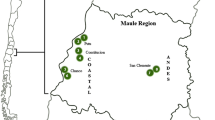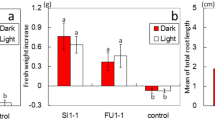Abstract
The identity and ecological role of fungi in the mycorrhizal roots of 25 species of mature terrestrial orchids and in 17 species of field incubated orchid seedlings were examined. Isolates of symbiotic fungi from mature orchid mycorrhizas were basidiomycetes primarily in the generaCeratorhiza, Epulorhiza andMoniliopsis; a few unidentified taxa with clamped hyphae were also recovered. More than one taxon of peloton-forming fungus was often observed in the cleared and stained mycorrhizas. AlthoughCeratorhiza andEpulorhiza strains were isolated from the developing protocorms, pelotons of clamped hyphae were often presents in the cleared protocorms of several orchid species. These basidiomycetes are difficult to isolate and may be symbionts of ectotrophic plants. The higher proportion of endophytes bearing clamp connections in developing seeds than in the mycorrhizas is attributed to differences in the nutritional requirements of the fully mycotrophic protocorms and partially autotrophic plants. Most isolates ofCeratorhiza differed enzymatically fromEpulorhiza in producing polyphenol oxidases. Dual cultures with thirteen orchid isolates and five non-orchid hosts showed that some taxa can form harmless associations with non-orchid hosts. It is suggested that most terrestrial orchid mycorrhizas are relatively non-specific and that the mycobionts can be saprophytes, parasites or mycorrhizal associates of other plants.
Similar content being viewed by others
Literaturer Cited
Alexander, C. and Hadley, G. 1983. Variation in symbiotic activity ofRhizoctonia isolates fromGoodyera repens mycorrhizas. Trans. Br. Mycol. Soc.80: 99–106.
Alexander, C., Alexander, I. J. and Hadley, G. 1984. Phosphate uptake byGoodyera repens in relation to mycorrhizal infection. New Phytol.97: 401–411.
Andersen, T. F. 1990. A study of hyphal morphology in the form genusRhizoctonia. Mycotaxon37: 25–46.
Arditti, J. 1992. Fundamentals of orchid biology. John Wiley & Sons, Inc. Toronto.
Currah, R. S. and Zelmer, C. D. 1992. A key and notes for the genera of fungi mycorrhizal with orchids and a new species in the genusEpulorhiza. Rep. Tottori Mycol. Inst.30: 43–59.
Currah, R. S., Hambleton, S. and Smreciu, A 1988. Mycorrhizae and mycorrhizal fungi ofCalypso bulbosa. Amer. J. Bot.75: 739–752.
Currah, R. S., Zettler, L. W. and McInnis, T. M. 1996.Epulorhiza inquilina sp. nov. fromPlatanthera (Orchidaceae) and a key toEpulorhiza species. Mycotaxon (in press).
Davidson, R. W., Campbell, W. A. and Blaisdell, D. J. 1938. Differentiation of wood-decay fungi by their reactions on gallic or tannic acid medium. J. Agric. Res.57: 683–695.
Dhillion, S. S. 1994. Ectomycorrhizae, arbuscular mycorrhizae andRhizoctonia sp. of Alpine and BorealSalix spp. in Norway. Arctic and Alpine Research26: 304–307.
Downie, D. G. 1957.Corticium solani—an orchid endophyte. Nature179: 160.
Fortin, J. A., Piché, Y. and Lalonde, M. 1980. Technique for the observation of early morphological changes during ectomycorrhizal formation. Can. J. Bot.58: 361–365.
Haug, I. and Oberwinkler, F. 1987. Some distinctive types of spruce mycorrhizae. Trees1: 172–188.
Hutchison, L. J. 1991. Description and identification of cultures of ectomycorrhizal fungi found in North America. Mycotaxon42: 387–504.
Masuhara, G. 1991. Ecological studies of the symbiosis between species ofRhizoctonia andSpiranthes sinensis. Tsukuba: Tsukuba University. Japan Ph D Thesis. (In Japanese).
Masuhara, G. and Katsuya, K. 1989. Effects of mycorrhizal fungi on seed germination and early growth of three Japanese terrestrial orchids. Scientia Horticulturae37: 331–337.
Mazzola, M. 1996. Classification and pathogenicity ofRhizoctonia spp. isolated from apple roots and orchard soil. Abstract. APS/MSA Joint Annual Meeting July 27–31, 1996, Indianapolis. Abstracts of Presentations, p. 5.
Milligan, M. J. and Wiliams, P. G. 1987. Orchidaceous rhizoctonias from roots of nonorchids: mycelial and cultural characteristics of field and pot culture isolates. Can. J. Bot.65: 598–606.
Peterson, R. L. and Currah, R. S. 1990. Synthesis of mycorrhizae between protocorms ofGoodyera repens (Orchidaceae) andCeratobasidium cereale. Can. J. Bot.68: 1117–1125.
Rasmussen, H. N. 1995. Terrestrial orchids from seed to mycotrophic plant. Cambridge University Press. Great Britain.
Rasmussen, H. N. and Whigham, D. 1993. Seed ecology of dust seedsin situ: a new study technique and its application in terrestrial orchids. Am. J. Bot.80: 1374–1378.
Richardson, K. A., Currah, R. S. and Hambleton, S. 1993. Basidiomycetous endophytes from the roots of neotropical epiphytic Orchidaceae. Lindleyana8: 127–137.
Richardson, K. A., Peterson, R. L. and Currah, R. S. 1992. Seed reserves and early symbiotic development ofPlatanthera hyperborea Orchidaceae. Can. J. Bot.70: 291–300.
Smith, R. E. 1977. Rapid tube test for detecting fungal cellulase production. Appl. Environ. Microbiol.33: 980–981.
Smreciu, E. A. and Currah, R. S. 1989. Symbiotic germination of seeds of terrestrial orchids of North America and Europe. Lindleyana4: 6–15.
Sneh, B., Burpee, L., and Ogoshi, A. 1991. Identification ofRhizoctonia species. APS press, St. Paul, Minn.
Taylor, L. and Bruns, T. D. 1995. Ectomycorrhizal specificity in the mycorrhizal association of the phantom orchid. Inoculum43: 41. (Abstract).
Terashita, T. 1985. Fungi inhabiting wild orchids in Japan (III).Armillaria tabescens, a new symbiont ofGaleola septentrionalis. Trans. Mycol. Soc. Japan.28: 145–154.
Umata, H. 1995. Seed germination ofGaleola altissima, an achlorophyllous orchid, with aphyllophorales fungi.Mycoscience 36: 369–372.
Väre, H., Vestberg, M. and Eurola, S. 1992. Mycorrhiza and root-associated fungi in Spitzbergen. Mycorrhiza 1: 93–104.
Warcup, J. H. 1985.Rhizanthella gardneri (Orchidaceae), its Rhizoctonia endophyte and close association withMelaleuca unicinata (Myrtaceae) in Western Australia. New Phytol.99: 273–280.
Zelmer, C. D. and Currah, R. S. 1995a. Evidence for a fungal liaison betweenCorallorhiza trifida (Orchidaceae) andPinus contorta (Pinaceae). Can J. Bot.73: 862–866.
Zelmer, C. D. and Currah, R. S. 1995b.Ceratorhiza pernacatena andEpulorhiza calendulina spp. nov.: mycorrhizal fungi of terrestrial orchids. Can. J. Bot.73: 1981–1985.
Zettler, L. W. and McInnis, T. M. Jr. 1992. Propagation ofPlatanthera integrilabia (Correll) Luer, an endangered terrestrial orchid, through symbiotic seed germination. Lindleyana7: 154–161.
Author information
Authors and Affiliations
Corresponding author
About this article
Cite this article
Zelmer, C.D., Cuthbertson, L. & Currah, R.S. Fungi associated with terrestrial orchid mycorrhizas, seeds and protocorms. Mycoscience 37, 439–448 (1996). https://doi.org/10.1007/BF02461001
Accepted:
Issue Date:
DOI: https://doi.org/10.1007/BF02461001




